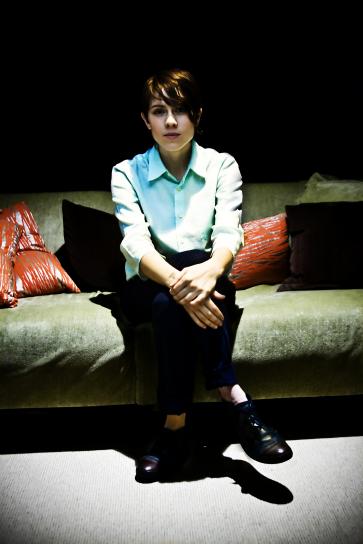Dese’Rae Stage is a New York City based photographer who makes pictures of people who make music.
Of her work, she says: “I've always loved the magic and mystery of rock 'n' roll and the iconic imagery it provides for pop culture. Shooting within that framework, I spend most of my time trying to be inconspicuous, waiting to catch the defining moment. I decided recently that I was limiting myself, and that portraiture was an interest. Instead of working with friends, I dove right in, and started (fearfully) to request time around shows or interviews where I could make images of a conscious, two-way interaction, as opposed to a stolen moment.”
Here are the pictures she sent:

 Top photo is of Sara Quin, bottom photo is of Tori Amos, but I guess it says that in the photo. Both photos by Dese'Rae Stage
Top photo is of Sara Quin, bottom photo is of Tori Amos, but I guess it says that in the photo. Both photos by Dese'Rae Stage
The pictures are two of her first portraits, what Dese’Rae calls guerilla portrait shoots - fast and dirty - where she made two-three frames each of Sara Quin and Tori Amos backstage.
Dese’Rae asks of me: “Ideally, I'd like to know if the images work on the whole and if they're evocative without the celebrity context. Which is better? Are they portfolio-worthy, or should I scrap them and keep trying?”
I tried writing a response without music playing here but it wasn’t working. Moby is helping the thoughts flow.
The pictures do work by themselves and get better when you know who the people are, to answer your first question. Each of them has something beyond the surface, you’d never know that you only had a couple seconds. In looking at your pictures of concerts I found the same to be true - there was a quality that went beyond performance. There is something of you in each of the pictures, a level of seeing that transcends event and says something about your experience with the setting.
With the Quin photo, it is the color palette and isolating strobe, the repetition of crosses - her hands and her body crossing the line of the couch - that elevate the image. Red and greeen of the pillows/couch create a nice contrast too. The kickback of light from her shirt to her chin creates a lovely dimensional happening. Without that touch, the picture would be much less of a picture.
At first blush on the Amos picture I reacted negatively to the sign, thinking it belied her elegance, but then I took it back. There’s great fun in the inclusion and the color of the wall plays beautifully against her hair in the same way that the gray of the door frame plays to the black of her outfit. The quality of light again makes the image succeed by giving depth to her face and separating her from the background.
Yes, I’d put both of them in your portfolio. They add a dimension. I prefer the Quinn photo over the Amos for its greater image quality but they’re not that much different.
And yes, keep trying. I don't want to overstate the quality of the images. They are damn good, given the context of their making, but are still a reflection of the extent of the connection and the possibilities such a setting offers. My guess is that you’ll peak fairly quickly in the two-second photo realm. There are only so many tricks in the bag with such time and setting limitations. I’d suggest scouting places in advance, knowing something of the performer that you can play off of, which will allow you to have a quality that you want to convey going into the setting to help guide your decisions of how to make a picture.
As long as you continue to make pictures that reflect a quality, you’ll continue to make new pictures.
I’d also suggest asking every one of the performers that you photograph if it’d be possible to photograph them at a down time, or away from the performance venue or at home or when they’re out with friends. Few are likely to say yes, but some might.
And the more performers who say yes to letting you spend time with them, the more dimensional your body of photographs is likely to be. And that’s a path that you can follow for a long time.
